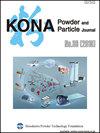大型流化床高固载高效气固旋风分离器研究进展
IF 3.2
4区 材料科学
Q3 ENGINEERING, CHEMICAL
引用次数: 8
摘要
循环流化床(CFB)由于其传质和传热速率大,是处理流体催化裂化、燃烧、气化和高温吸热等气固系统的重要技术设备。旋流器是控制循环流化床性能、保证循环流化床稳定运行的重要装置;在循环流化床中循环的载热和/或固体催化剂颗粒应在分离过程中减少压力损失的情况下有效地从气体中分离出来。在商业循环流化床中,有大量的固体(> 1kg -solid (m3 -gas) -1或> 1kg -solid (kg-gas) -1)循环,需要进行处理。因此,应开发具有高固体负荷的气固旋风分离器。已经发表了大量关于气固分离器的报告,包括旋风分离器。此外,计算流体力学(CFD)技术在过去十年中得到了迅速发展。在此基础上,本文综述了近年来气固旋流器的实验和CFD研究进展。修正的压降模型,放大的方法,和标准的一个大旋风与多个旋风的解释。展望了未来的研究方向。本文章由计算机程序翻译,如有差异,请以英文原文为准。
Recent Progress in Efficient Gas–Solid Cyclone Separators with a High Solids Loading for Large-scale Fluidized Beds
Circulating fluidized beds (CFB)s are important technical equipment to treat gas–solid systems for fluid catalytic cracking, combustion, gasification, and high-temperature heat receiving because their mass and heat transfer rates are large. Cyclones are important devices to control the performance of CFBs and ensure their stable operation; heat-carrying and/or solid catalyst particles being circulated in a CFB should be efficiently separated from gas at a reduced pressure loss during separation. In commercial CFBs, a large amount of solids (> 1 kg-solid (m 3 -gas) –1 or > 1 kg-solid (kg-gas) –1 ) is circulated and should be treated. Thus, gas–solid cyclones with a high solids loading should be developed. A large number of reports have been published on gas–solid separators, including cyclones. In addition, computational fluid dynamics (CFD) technology has rapidly developed in the past decade. Based on these observations, in this review, we summarize the recent progress in experimental and CFD studies on gas– solid cyclones. The modified pressure drop model, scale-up methodology, and criteria for a single large cyclone vs. multiple cyclones are explained. Future research perspectives are also discussed.
求助全文
通过发布文献求助,成功后即可免费获取论文全文。
去求助
来源期刊

KONA Powder and Particle Journal
工程技术-材料科学:综合
CiteScore
8.40
自引率
4.90%
发文量
35
审稿时长
>12 weeks
期刊介绍:
KONA publishes papers in the broad field of powder science and technology, ranging from fundamental principles to practical applications. Papers describing technological experience and critical reviews of existing knowledge in special areas are also welcome.
 求助内容:
求助内容: 应助结果提醒方式:
应助结果提醒方式:


